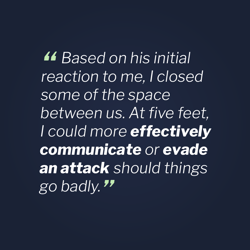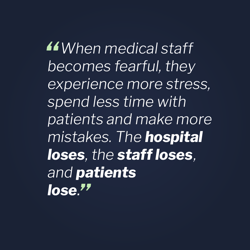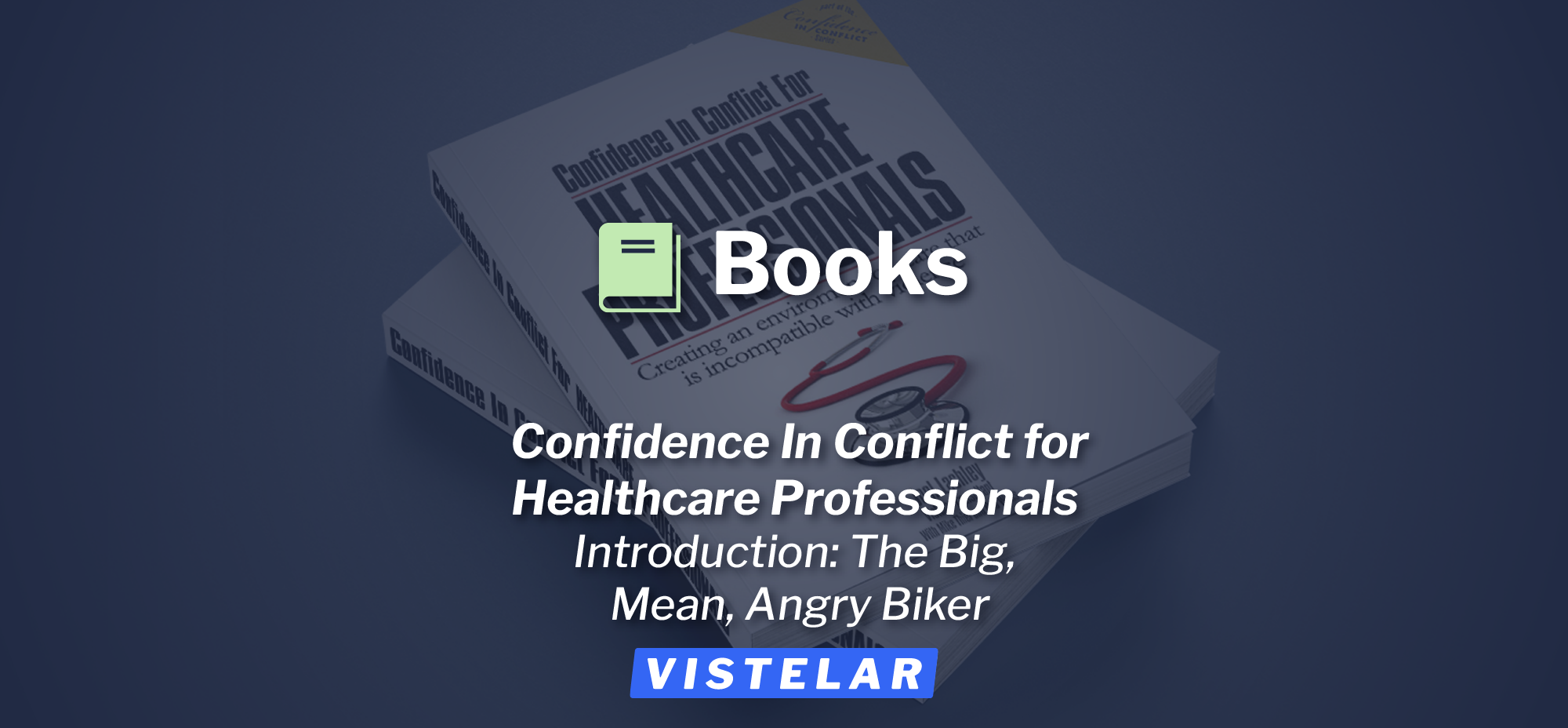Enjoy this excerpt from one of our published books.
Introduction
I was passing through the Emergency Department when an angry-looking man walked in through the front door. He was a hard figure to miss. He wore a denim jacket with the sleeves torn off and emblazoned on his makeshift vest were the colors of a well-known and notoriously violent motorcycle gang. His bare arms were heavily inked with gang colors, lewd images, swastikas, and various weapons.
He was at least six and a half feet tall and easily weighed over 300 pounds. His long bushy hair flowed over his shoulders. His beard was equally impressive, reaching all the way down to his pistol-shaped belt buckle. His wide black belt was encrusted with pointed metal studs and a long heavy chrome chain secured his wallet to it. His jeans were tucked into his tall studded motorcycle boots, which could easily have concealed a knife or small-framed handgun.
The big man stood in the lobby with his feet apart, his huge fists clenched, and wearing an obvious look of disgust on his face. Without saying a word, he commanded the room as all eyes were on him. Finally, he shouted, “Where am I supposed to park my f***ing van?!” You could have heard a pin drop. Everyone in the room froze, staff and patients alike.
I was dressed in a suit and didn’t look particularly intimidating. Still, I decided to address the big man. I walked towards him with a look of confident concern on my face, because when people are angry they don’t want to be smiled at. I didn’t stand directly in front of him. Instead, I stood about ten feet away with my feet apart and my hands out in front of me. At ten feet, I could quickly evaluate or exit the scene if he suddenly flew off the handle. As soon as I was in position, I began to speak.
Universal Greeting
“Hello, Sir. I’m Joel. I work here in the hospital.” Now the big man looked directly at me. “I can help you with your van, but can I ask you not to yell or curse? There are kids and families around. Let me help you out.” The man looked at me with an expression of angry shock. In my peripheral vision, I could see nurses backing away and seeking safety. After a short pause, he spoke again. This time more quietly.
“Whatever,” he replied. “Where am I supposed to park around here? The lot is full.” Based on his initial reaction to me, I closed some of the space between us to about five feet so we could communicate more effectively without crowding each other. At five feet, I could more effectively communicate or evade an attack should things go badly.
to me, I closed some of the space between us to about five feet so we could communicate more effectively without crowding each other. At five feet, I could more effectively communicate or evade an attack should things go badly.
“You’re in luck.” I answered. “Let me get a valet to park your car. Valet service is free here.”
“I don’t want anyone driving my f***ing van!” he shouted back. “I don’t need anyone else in my f***ing van!” Clearly, he wasn’t getting the message, so I continued.
“Sir, I have to ask you again not to yell or curse. There are patients and children around and this has to be a safe place for them. You’re a big guy and you’re scaring everybody. We can’t allow that in the hospital, so please stop.”
The big biker looked down at me and sighed, before answering me in a strained whisper. “Whatever. Where can I park, then?” Now satisfied that he was going to cooperate, I moved up within two feet of him so we could talk without compromising patient confidentiality. Two feet is the distance at where I could operate or escape, if necessary. First, I asked him if he was in need of emergency care. He explained that he was here to visit his son. I asked him his son’s name and checked with the triage nurse to make certain the child was in the Emergency Department and that there was no dire medical emergency. The biker became visibly calmer because information equals peace. One of the main reasons people act out in clinical situations is fear or frustration linked to a misunderstanding or a lack of basic information.
Then came the hard part. I told him that, if he didn’t want to use the valet service, he would have to park several blocks away on the other side of the campus. He would then have to come through the main hospital entrance. Once there, he would have to get a visitor pass and directions back to the emergency department. Of course, that made him angry again. “Whatever. This is ridiculous,” he snarled under his breath, but this time without cursing or yelling. He then turned and walked back out into the parking lot.
Proxemics 10-5-2
Several minutes later the big, mean, angry biker appeared at the visitors’ center in the main lobby. There were a lot of people in line, so he soon lost his temper. “This is ridiculous,” he yelled! “How do I get to the f***ing emergency room from here? I don’t have time for this bulls***!” The security officer assigned to the hospital lobby overheard him and didn’t waste any time responding. Being mindful of his proxemics, i.e., managing his distance to the subject depending on the level of threat, he approached with caution and began eva!uating the subject at ten feet away. When he was satisfied that the big biker was unarmed and not actively aggressive, he approached with caution up to five feet where he could communicate. Then he stood and spoke as trained.
“Sir, I’m Mark, with security”.
“So?” replied the biker, rolling his eyes.
“I will help you get to the emergency department, but please stop cursing and yelling. We have to keep things quiet and peaceful in the hospital for the patients.”
The big biker snarled back, saying “Are you for real?”
Now relaxed but ready at five feet away, the officer simply smiled and continued, “Look, you’re going to give some heart patient another heart attack! We have to keep things calm around here.”
To that, the big biker finally smirked and shook his head. Then he replied, using his word of choice. “Whatever. Just get me over there, will you?” The officer then stayed on track, now operating at two feet he made sure everything was in order before taking the biker to the Emergency Department.
“My pleasure. First, we have to get you a pass. Who are you here to see today?” While the security officer assisted the big biker, I was waiting back at the Emergency Department to see what would happen when the big biker showed up again. When he finally arrived, it was the triage nurses’ turn with him.
Be Consistent
"Hello, I’m Amy. I’m the nurse who is checking in your son. I have to ask you some questions about him. It should only take a few minutes. First, how do you spell his first name?”
The big biker looked annoyed again, “Are you kidding? His name is Jerry.”
“Jerry or Gerald” she continued, unshaken. The biker looked puzzled, “Uh, Gerald” “With a G or a J?” she asked.
“J, I think.” answered the biker, “Isn’t that in his records or something?”
“Oh sure,” said the nurse. “That is if he’s been here before. We need proper spelling to find his record or it will take much longer. Now, how do you spell his last name?” To that, the biker obediently spelled out the boy’s last name. Then she continued to question the biker, “Is he on any medications?”
“Isn’t that in the records, either?” he asked.
“Possibly, but your boy may have been prescribed new meds by his doctor since he was last here. We need that information to keep him safe.”
The big biker answered, but continued to do what uncooperative people do. He challenged every question and resisted every step. In response, the nurse did what trained and capable communicators do when they meet verbal resistance: used Redirections. She was clearly a master of this tactic. She deflected all his resistance by acknowledging each question, while still keeping the biker on track. And she did it with one simple word, the word “but.”
When she was finished, she sent the biker over to registration. He refused to sit when the young registration woman offered him a seat, so she just started in with her questions. “How do you spell your child’s name?” The biker grew visibly annoyed again.
Inconsistency is the Enemy of Peace
“Are you kidding? Can’t you just ask her?” while gesturing toward the triage nurse.
“Yes, but she’s with another patient right now. Can I just ask you for his name again, please? Then I can quickly verify his address and insurance.” The young woman did a very nice job of using the Redirections tactic and keeping the biker on track, just as the nurse had done. All seemed to be going along smoothly until the young woman advised him that he wasn’t the father of record. Finally, he began to shout again.
“That’s not right! I pay this kid’s bills!” Because the biker was shouting again, his behavior had to be readdressed. That said, there was still a noticeable change in the biker’s behavior. He wasn’t cursing. Even after this stumble, he was still actively modifying his normal behavior.
When he began to shout, the young woman rolled back in her chair a few feet and kept the counter between them, as trained. She then replied by simply stating, “Sir, please don’t shout. There are sick people and kids around, and you’re making them feel unsafe.” Her expression was concerned and her tone of voice was professional and confident. The biker stopped yelling but continued at a low volume.
“That ain’t right!” he whispered hoarsely. The registration person also explained that, since he wasn’t a legal guardian or adoptive parent, he could not give permission to treat. The biker was now beside himself with anger. “I’m going to sue this place,“ he whispered angrily. “I can’t believe this!” His face was red and he pointed his finger at the registration person, as he raged on in whispered tones.
The registration person kept the counter between them and stayed out of reach, while he quietly vented. She empathized by saying, “I understand that you’re angry, but our hands are tied because it’s the law. Help me get a hold of his mother, so we can make sure he gets all the care he needs as quickly as possible. In the meantime, they will care for him as necessary, until we can get a hold of her.”
With that, the biker calmed down enough to answer the rest of her questions. She then gestured towards the waiting area and asked him to take a seat. But, if you know anything about tough guys, no one tells them to sit down, especially women! So he stood there like a statue, unmoving and waiting for someone to take him back to the treatment area to see his girlfriend’s son.
After a few tense seconds, the registration person simply looked up at the man and confidently stated, “Sir, can I ask you again to take a seat, please? I assure you that they will call you soon. I have other people waiting in line.” At that, the biker looked around the room at all the faces he hadn’t taken notice of before. Some of them were staring uncomfortably off into space. Others looked at him with a puzzled or disgusted expression. Then he simply turned, walked to the waiting area, and sat down.
With things settled down for the time being, I went back to the treatment area to advise the medical staff about what had just transpired. They assured me that they would call security quickly if the man started up again, as his behavior had already been addressed several times. I then went on to my meeting.
"He Was Pleasant"
A couple of hours later, I walked back to the emergency department to see how things were going. I asked the doctor how the big biker was doing. “He’s fine. No problems. You shouldn’t judge a book by its cover, you know,” he said smugly. I then went to the nurse who was working with the boy, his mother, and the biker. She described the big biker as “pleasant.” When the biker left later that day, he stopped by the visitors’ center and apologized to the people working there, stating that he was sorry he’d behaved like a jerk. Then the formerly big, mean, angry biker, his girlfriend, and her son walked out towards the parking lot.
What could account for such a transformation? Was it his girlfriend perhaps? Not likely, she hadn’t shown up until way after the biker had been given permission to see the boy. The nurse also said he’d already become “pleasant” long before his girlfriend arrived. So then what could account for the change? Perhaps we can figure it out by asking what he may have been like, if he’d been handled a different way.
Would the biker’s behavior have changed, if I’d ignored him and allowed him to yell and curse? Would it have gotten worse or better? Perhaps I could have told him just to leave his car parked in a no-parking zone and not to worry about it. That might have appeased him until he got a parking ticket. Appeasement rarely works anyway. Mike Thiel, the Director of Security at Children’s Hospital of Wisconsin likes to put it this way: “appeasement equals encouragement for more bad behavior.” Also, mere appeasement doesn’t address the underlying problem.
When we fail to resolve problems, in favor of ignoring them, they usually become bigger problems. Still, this is the direction we usually go when we encounter anti-social and even threatening behavior in hospitals and clinics. We follow the path of least resistance to get the angry and threatening person out of our way; and following the path of least resistance almost always leads to failure.
Does Appeasement Work?
What if when he questioned the triage procedure, the nurse offered to simply wait and ask the child’s mother when she arrived? Might that have worked? Or would she have placed the patient in greater danger, by not having timely information about medications, food intake, conditions, allergies, etcetera? Also, that would be just more appeasement, i.e., more validation of the illusion that bad behavior gets results.
If the registration person had just let the biker vent, as she’d heard people say before, would he have gotten everything off his chest and been fine, or would his bad behavior have escalated? If at every step, the biker had been treated with kid gloves, given a wide berth, and killed with kindness—in other words, embraced all the advice nurses are given throughout their careers—would he have turned into this nice pleasant man they encountered in the treatment area or would he have been something entirely different?
encountered in the treatment area or would he have been something entirely different?
In reality, he would have been taken down a path toward violence. He would have continued to be loud, obnoxious, and threatening. As a result, other patients and families would have been disturbed, the emergency medical staff would have become fearful, and the patient would have been over-stimulated. When other patients and families are disturbed, they complain and even consider going elsewhere for their medical care. When medical staff becomes fearful, they experience more stress and many consider seeking new employment. Worst of all, medical staff may spend less time with patients and make more mistakes. The hospital loses, the staff loses, and patients lose.
Appeasement in the face of anti-social and threatening behavior is the path we most often take in human service work, all because of a mythology that exists about violence in our workplace and how it should be handled. That is, a mythology that directs us to legitimize and even reward anti-social and threatening behavior. What are these myths? Why do we continue to embrace them and pass them on, even in the face of so many failures? First, we need to recognize what these myths are, before we can go in another direction.
Also, we have to ask ourselves, does the biker behave this way in all situations and in all places? Would he have behaved the same way in a church or a library? Perhaps, but it’s not a foregone conclusion. Can we assume that, if he behaved that way in a library or church, he wouldn’t be welcome there?
So what made the intervention with the angry biker successful? What stands out most is the consistent response from the staff. Inconsistency is the enemy of peace. Consistency, on the other hand, is the basis for all successful interventions and the ultimate exclusion of unwanted behavior within a relationship or group.
The “Big, Mean, Angry Biker” story is just one of thousands from my thirty-plus years of work in public safety. I’ve repeatedly encountered people just like him and I’ve seen the good the bad and the ugly that can result from the wide range of approaches used to address challenging behaviors like his.
My Background
I first got into the security field in 1981 and began my career in healthcare security in 1985 at a large urban residential and sub-acute care facility. Since then, I’ve worked in everything from small community-based social service agencies to busy urban medical centers.
For 18 years, I worked at Children’s Hospital of Wisconsin, where I finished out my service as the security training coordinator for the security, healthcare, social services, and behavioral health staff and other providers from virtually all disciplines. During my tenure there, I had the privilege to learn from many wonderful mentors, including Mike Thiel (who wrote the Foreword to this book), Dr. George Thompson (founder of the Verbal Judo Institute), Gary Klugiewicz (co-founder of Vistelar), and countless nurses, doctors, behavioral health therapists, all types of other healthcare professionals, patients, and their parents. Together, we transformed the environment of care for everyone — provider and patient alike.
Currently, I work at Aurora Health Care where I supervise security operations for community clinics in Wisconsin. Aurora is a large integrated healthcare provider with over 31,000 employees, 15 hospitals, over 150 clinic sites, and more than 7.5 million annual patient encounters.
In addition, I am a Law Enforcement Crisis Intervention Teams Instructor for the National Alliance on Mental Illness (NAMI), and a member of the International Law Enforcement Educators and Trainers Association (ILEETA).
In 2005 I was introduced to the Vistelar conflict management methodologies, which you’ll learn about in this book. The class I attended was co-taught by Gary Klugiewicz, a professional trainer who began teaching verbal intervention skills to police officers in the early 1980s.
Gary and some others formed a company called Vistelar in 2009 to bring these verbal intervention principles and other conflict management training to other disciplines beyond law enforcement, including healthcare. Shortly thereafter, I became a Certified Consultant for Vistelar, which I still am today.
Vistelar is a consulting and training institute focused on addressing the entire spectrum of human conflict at the point of impact—from before an interaction begins through to the consequences of how an interaction is managed. A lot of what you’ll learn in this book is embedded in Vistelar’s conflict management training curriculum.
Several years ago I began telling the “Big, Mean, Angry Biker” story to everyone who would listen. I told it at every nursing orientation for every newly hired RN and nursing assistant. I told it at every nursing in-service I taught. I shared the story with providers in the emergency department, critical care units, urgent care clinics, doctor’s offices, day surgery clinics, renal clinics, social service agencies, and psychiatric clinics. Anywhere and everywhere that people were concerned with reducing disruptive behavior and violence within their walls, I shared this story.
Soon, I ended up taking this story and the concepts it represents, such as Gateway Behaviors of Vio!ence, Social Contracting, and Crisis Intervention on the road, as calls came in from national healthcare and campus safety organizations. I’ve taught these principles all over the country, not only in hospitals but also at police departments, schools, and even jails.
Everywhere the “Big Mean, Angry, Biker” story and I went, I saw it transform the minds of people who are steeped in violence daily and at a total loss for what to do about it. I don’t know the biker’s name, but if I did, I’d like to shake his hand and thank him for teaching me some of the most important lessons I ever learned. I like to think he learned something from that experience as well.
Everyone who works in healthcare needs to know this story and learn what we did to turn the biker on a different path — a path towards peace for providers and patients, and a better patient experience for himself. My primary goal with this book is to share the lessons I’ve learned over the last three decades with individual healthcare providers who, every day, face disrespect and violence.
Disrespect and violence — they no longer have to be accepted as just “part of the job.”









.png)